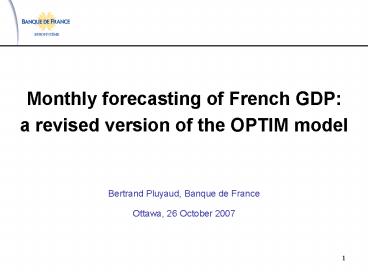Monthly forecasting of French GDP: PowerPoint PPT Presentation
1 / 19
Title: Monthly forecasting of French GDP:
1
- Monthly forecasting of French GDP
- a revised version of the OPTIM model
- Bertrand Pluyaud, Banque de France
- Ottawa, 26 October 2007
2
Monthly forecasting of French GDPa revised
version of the OPTIM model
- Description of OPTIM
- Modelling strategy and data selection
- Results
- Conclusion
3
1. Description of OPTIMThe main characteristics
- Bridge model created by Irac and Sédillot (2002)
- New version by Barhoumi, Brunhes-Lesage, Darné,
Ferrara, Pluyaud and Rouvreau (2007) - Forecasts for French GDP and its components for
the current quarter (and for the next one, in a
forthcoming version) - Based on monthly indicators (survey data and hard
data) - Used at the Banque de France, coupled with the
structural macroeconomic model Mascotte or
separately
4
1. Description of OPTIMA revised version of the
model
- New equations
- Monthly forecasts (previously quarterly
forecasts) - Systematic data selection using Gets
5
2. Modelling strategy and data selectionModelled
components (1/3)
- French GDP quarterly growth rate GDP components
quarterly growth rate - Some components are not modelled(production of
non market services, immaterial investment,
changes in inventories) - Aggregation with equations
6
2. Modelling strategy and data selectionModelled
components (2/3)
- On the demand side
- Household consumption, computed by aggregation
of the forecasts for - Household consumption in agri-food goods
- Household consumption in energy
- Household consumption in manufactured goods
- Household consumption in services
- Government consumption
- Investment, computed by aggregation of the
forecasts for - Corporate investment in machinery and equipment
- Corporate investment in building
- Household investment
- Government investment
- Exports
- Imports
7
2. Modelling strategy and data selectionModelled
components (3/3)
B. On the supply side Total Production,
computed by aggregation of the forecasts
for Production of agri-food goods Production
of manufactured goods Production of
energy Production in construction Production of
market services C. Total GDP is forecast using
a regression on total production.
8
2. Modelling strategy and data selectionMonthly
exercises
- 3 forecasts for each quarter
- After the publication of Insee and EC surveys and
before the ECB monetary Governing Council - different equations can be used for the different
forecasts of a component - When data are missing for some months of the last
quarter, the value for the quarter is computed as
the 3-month moving average of the last available
observations
9
2. Modelling strategy and data selectionThe data
set (1/3)
- Monthly or higher frequency data
- Soft (survey) data and hard data
- Recent information (less than 2 months)
10
2. Modelling strategy and data selectionThe data
set (2/3)
11
2. Modelling strategy and data selectionThe data
set (3/3)
Nov. IPI
Dec. IPI
Jan. IPI
Feb. IPI
Mar. IPI
Apr. BdF survey
Mar. BdF survey
Dec. BdF survey
Jan. BdF survey
Feb. BdF survey
Feb. cons. in manuf. goods
Mar. cons. in manuf. goods
Apr. cons. in manuf. goods
Jan. cons. in manuf. goods
Dec. cons. in manuf. goods
Feb. Inseeand EC surveys
Apr. Inseeand EC surveys
May Inseeand EC surveys
Mar. Inseeand EC surveys
Jan. Inseeand EC surveys
January
February
March
April
May
1st forecast for Q1
2nd forecast for Q1
3rd forecast for Q1
Q1 GDP release
Q4 GDP release
12
2. Modelling strategy and data selectionGeneral
specification of the equations
- Autoregressive-distributed-lag (ADL) bridge
equations
13
2. Modelling strategy and data selectionData
selection procedure (1/2)
- Systematic data selection using Gets
- Preselection of explanative variables strongly
correlated with the modelled variable but not
with each other - No mix between similar data sources
- No use of synthetic survey indicators
- Selection of a first set of equations with an
emphasis on economic content - Final selection with rolling forecasts, taking
into account the data availabilty
14
2. Modelling strategy and data selectionData
selection procedure (2/2)
Preselection of variables based on correlations
Selection of variables with Gets
Selection of a main data source
Selection of a complementary data source
Refinement of equations
First set of equations
Rolling forecasts
Final set of equations
15
2. Modelling strategy and data selectionTests
implemented in Gets
- Godfrey (1978) Lagrange multiplier test for
serial correlation in the residuals up to 5 lags
LM(5) - Doornik and Hansen (1994) normality test DH
- Nicholls and Pagan (1983) test for quadratic
heteroscedasticity between regressors NP - Chow in-sample predictive failure test on 50
Chow(50) and 90 Chow(90) of the sample - Belsley, Kuh, and Welsch (1980) multicollinearity
diagnostic BKW
16
3. ResultsGDP forecasts
17
3. ResultsRoot Mean Squared Errors
18
3. ResultsDiebold-Mariano tests against the AR
model
- Diebold Mariano tests against the AR model
- Modified version by Harvey, Leybourne and Newbold
(1997), not presented in the paper
19
4. Conclusion
- Satisfying results given the comparisons with
benchmarks - Next step future quarter forecasts
- Problems concerning the aggregation of forecasts
for GDP components

